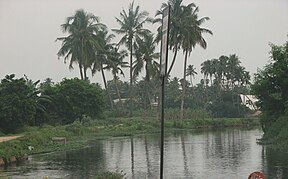Kalingarayan Canal
| Mamannar Kalingarayan Canal | |
|---|---|
 Canal near Cauvery - Erode | |
| Specifications | |
| Length | 56.5 miles (90.9 km) |
| Status | open |
| History | |
| Date completed | 1283 |
| Geography | |
| Branch of | Bhavani River |
Mamannar Kalingarayan Canal is a 56.2-mile (90.5 km) long irrigation canal in the Erode district, Tamil Nadu, India. It was constructed by Kongu Nadu Chieftain Mamannar Kalingarayan Gounder and completed in 1283. The canal's source is the Kalingarayan Anicut dam near Bhavani, Erode. The canal irrigates approximately 15,743 acres (6,371 ha) of agricultural land.[1]
Project, including the canal and the Kalingarayan Anicut dam started in 1271 and was completed in 1283, taking over 12 years.[2] The dam was constructed by Kalingarayan king.
Course and architecture[edit]
The canal connects Bhavani and Noyyal rivers, two major tributaries of the Kaveri. It is one of the oldest river linking projects in India.[3][4] The Canal starts at Kalingarayan Anicut on Bhavani river and joins Noyyal river near Kodumudi. The canal is 56 miles (90 km) long and was designed to reduce the water current, to avoid damage to the canal banks and to increase the ground water table.[5] The canal crosses three other canals via aqueducts.[6]
- Sunnambu Canal near Suriyampalayam
- Pichaikaranpallam Canal near BP Agraharam
- Perumpallam Canal near Karaivaikkal[7][8]
Environmental Threats[edit]
As the initial portion of the canal runs through the highly industrialized and urbanized areas of Erode Municipal Corporation, the discharge of untreated effluents from the textile dyeing units and leather tanneries introduce major pollutants.[9] To prevent mixing of sewage into the canal, the Government of Tamil Nadu have built concrete walls on the sides and a baby canal of 15 kilometres (9.3 mi) has been constructed alongside the main canal to carry the sewage. The entire stretch of first 30 km (19 mi) of the canal running through Erode Municipal Corporation is proposed to be provided with concrete lining and baby canal in phased manner.[10][11] Also, navigable roads were developed along the banks throughout this stretch.[12][13]
See also[edit]
References[edit]
- ↑ "Kalingarayan sluices opened, Erode all set for farming". The Hindu. Retrieved 23 December 2016.
- ↑ "Kalingarayan Canal is 725 years old". The Hindu. Retrieved 23 December 2016.
- ↑ Kalingarayan Canal Water Quality Study (PDF). Central Pollution Control Board. Retrieved 23 December 2016.
- ↑ "Memorial in Honour of Kalingarayan-CM". New Indian Express. Retrieved 23 December 2016.
- ↑ "காலிங்கராயன் கால்வாய் வளைந்து செல்வது ஏன்?". Dinakaran. Retrieved 23 December 2016.
- ↑ "Kalingarayan Canal turns 727". The Hindu. Retrieved 23 December 2016.
- ↑ "Sewage, a threat to Kalingarayan Bridge". The Hindu. Retrieved 23 December 2016.
- ↑ Kalingarayan the Great and the Kalingarayan Canal, page-43 (PDF). N.Pushparaj-Pavendhan Memorial Trust. Retrieved 23 December 2016.
- ↑ "Pollution of Kalingarayan Canal continues unabated". The Hindu. Retrieved 23 December 2016.
- ↑ "Erode Kalingarayan Canal to get a facelift soon". The Hindu. Retrieved 23 December 2016.
- ↑ "More water flow into Kalingarayan Canal brings relief for tail-end farmers". The Hindu. Retrieved 23 December 2016.
- ↑ "Expedite third phase of Concrete lining of Kalingarayan Canal". The Hindu. Retrieved 23 December 2016.
- ↑ "Minister inspects Kalingarayan Canal works". The Hindu. Retrieved 23 December 2016.
Coordinates: 11°03′N 77°54′E / 11.050°N 77.900°E